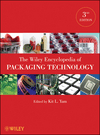Rethinking the ban on EPS
Study shows EPS is good for environment

Recent efforts in California, Chicago and New York to ban EPS products such as packing peanuts and foodservice items are being challenged by environmentalists and industry experts who argue that the bans will do more harm than good.
While EPS foam was once thought to be environmentally unfriendly, the new study “Impact of Plastics Packaging on Life Cycle Energy Consumption & Greenhouse Gas Emissions in the US & Canada Substitution Analysis”proves otherwise. Data from the report, which was compiled by Franklin Associates for the American Chemistry Council (ACC) and the Canadian Plastics Industry Association, shows that replacing plastic packaging with alternative materials would result in 4.5 times more packaging weight based on figures from 2010, as well as an 80 percent increase in energy use and 130 percent more global warming potential.*
The study shows the unintended results of bans on plastic packaging. Glass alternatives come with higher environmental costs in terms of manufacturing, transportation, and even recycling.
Along with the environmental benefit, EPS foam is the best shipping material for shock absorption and thermal protection. Insulated EPS wine shipping containers protect fine wines from breakage and temperature fluctuations during transit. Because of EPS shipping containers, mail order steaks stay frozen to perfection and temperature-sensitive and fragile pharmaceuticals remain viable.
The same EPS foam that protects wines, meats, and pharmaceuticals can be commercially recycled. Corporations like Chick-Fil-A, Walmart, and Best Buy have launched EPS recycling initiatives that have been hugely successful—reducing each of the corporations’ environmental footprint and providing feedstock to manufacturers of recycled content products.
Of EPS foam cups, the Chick-Fil-A website says: “We continually receive positive customer feedback on the insulating properties of our cups. Through research and tests of a number of ‘environmentally-friendly’ cup options, we have concluded that none serve our customers as well as the foam cup.” Surprisingly, most paper based cups use a glue that prevents them from being recycled. Chick-Fil-A is among one of the first restaurant chains in the country to successfully implement a large-scale foam recycling program. With the help of Dart Container, Chick-Fil-A is now recycling foam cups at 25% of its 1700 locations, and plans on reaching the 100% mark by 2015.
ACH Foam Technologies works to promote EPS recycling programs. “Throughout history, leading by example has always been very powerful,” says Mary Burk, ACH Foam’s marketing specialist. “The examples recently set by Chick-Fil-A, Walmart, and Best Buy will serve as models for other companies who want to reduce their carbon footprint. However, corporate programs are only one piece of the EPS recycling matrix. We hope businesses will take the following examples and spin their own creative ideas into the mix,” adds Burk.
There is a high demand for recycled EPS, which can be used in frames, hangers, interior moldings, surfboards, and other products. Recycled EPS costs less than wood. Right now, the supply of recycled foam is not keeping up with demand—an incentive for would-be recycling entrepreneurs.
Innovative EPS Recycling Programs:
Waste to Waves is a recycling program from Sustainable Surf, sponsored by Reef and Spy, and in partnership with Marko Foam and Surfrider Foundation. This award-winning EPS recycling program in California aims to recycle EPS into new surfboards. Co-founders Michael Stewart and Kevin Whilden developed a turnkey program that offers Californians a way to keep EPS out of the ocean, beaches and landfills. Waste to Waves collection bins are located at surf shops listed on their website. From there, the EPS is collected by Marko Foam and densified into bricks, which go to a raw material supplier that reprocesses the EPS into surfboard blanks. The Waste to Waves website is not only comprehensive, but entertaining and educational.
ReFoamIt® (refoamit.com) of Leominster, MA, received the Excellence in EPS Recycling Award from the EPS Industry Alliance March 12, 2014 for their unique off-site collection program and their commitment to recycle both colored and foodservice EPS products.
ReFoamIt’s story began in 2007. Owners Barbara and David Sherman had a friend who rented a warehouse space in Rhode Island. David said, “[Our friend] Ron allowed a sales rep to demonstrate a foam densifying machine, which started him thinking about recycling EPS Foam. He bought a machine, and he once started and discovered that foam is mostly air, and he didn’t have enough product to keep his machine running.”
Inspired by their friend, the Shermans launched ReFoamIt in 2009. They decided this was an opportunity to do something positive for the environment while making money. They set out to collect enough EPS foam to keep their friend Ron’s machine running.
Barbara grew up with recycling in the family. “It’s funny—it wasn’t until after we started ReFoamIt that I remembered my grandfather was in the recycling business,” Barbara said. “I remember, while growing up, seeing newspapers stacked floor to ceiling in my grandfather’s garage. He’d collect them in his pickup truck, and when the garage was full he’d sell them. Obviously, recycling is in my blood.”
ReFoamIt bought a landscaping trailer and box truck, and then set up collection events at various sites. “The first was a church event in Framingham spearheaded by my mom,” explained Barbara. “That event became a model for other towns, and we began to see our volume increase. We then transported it to Ron’s densifier, where it was compressed and sold to manufacturers.” The original church program has become a regular event every third month, and ReFoamIt collects between 60 and 80 cubic yards of foam each time.
By January 2013, the Shermans were so busy, they acquired their own densifier, which could process 800 pounds of EPS each day. Just one month later, they had outgrown the machine and began searching for a second one. Because a densifier can run anywhere from $35,000 to $80,000, Dave started to look for used machines. By August, he found one on eBay with the capacity to process 800 pounds of EPS every hour.
“One tractor-trailer can hold about 38 to 40,000 pounds of densified EPS—and all of it will be turned into new products. Before it’s densified, that same amount of foam would fill 50 trailers,” explains Barbara. “That’s exciting.”
One of the big startup costs is finding the network of buyers. “It’s a referral-based system, so you have to work hard getting started. Once you’re in the game though, the growth of the business pretty much takes on a life of its own. In 2013 ReFoamIt processed a total of 65 tons of foam.”
Next step: ReFoamIt is working toward recycling #4 Polyethylene and #5 Polypropylene in addition to #6 EPS foam. The company is flexible and will design a program to fit just about anyone’s needs.
Dart Container Corporation
No EPS recycling article would be complete without checking in with Dart Container. Dart is a major manufacturer of EPS foam foodservice products such as foam cups, and has been instrumental in the development of corporate EPS recycling programs. Dart can recycle large volumes of EPS, and there are eighteen Dart recycling centers in the US, Argentina, and the United Kingdom.
Dart has become theone-stop shop for everyone from businesses to schools to learn how to recycle foam. Through their Recycla-Pak and CARE (Cups Are Recyclable) programs, Dart is spreading the word about foam recycling.
Their most recent initiative is the Home for Foam website, which explains how schools, businesses and city governments can recycle EPS.
Recycling, Curbside
Curbside recycling programs are another important focus for the EPS recycling initiative. California is now offering curbside recycling in 65 cities, catering to 22 percent of its population. Other states have a long way to go before catching up with the Golden State. Dart’s How to Include Foam #6 in Municipal Recycling Programs and the EPS Industry Alliance’s PS: Think Recycling are great how to documents on foam recycling.
The EPS Industry Alliance (EPS-IA, epsindustry.org) has mounted an aggressive recycling campaign and helps companies and municipalities set up EPS recycling programs. Recent attempts to ban packaging peanuts in Chicago and New York may be on hold. According to EPS-IA Executive Director Betsy Steiner, the loose fill may be exempted from the bans based on efforts to expand the existing mailing store take back program run by EPS-IA.
More Grassroots Efforts:
- Camp Pendleton, CA Marine Corps Base is recycling all EPS to help meet Department of Defense waste reduction mandates.
- Minneapolis/St. Paul - Appliance retailer Warners’ Stellian found that 70 percent of the waste by volume in its 40-cubic yard waste container was foam. The garbage hauler was coming two or three times a week to empty it.The appliance retailer invested in a foam densifier. Now, it sells the foam and saves $2,500 per month in hauling fees.
- Minnesota’s state legislature passed a law this year that will require businesses to order bins and put up the signs for cans, bottles and plastic when recycling becomes mandatory in the state on Jan. 1, 2016. Under the new law, retailers, wholesalers, service companies, and other industries in the metropolitan Twin City area that use garbage bins of four cubic yards or larger will have to recycle at least three items.
- Environmental Defenders of McHenry County, IL holds an EPS recycling drive every two weeks.
- Baltimore Washington Medical Center recycles its cafeteria EPS waste continuously.
- Winnetka, IL offers a year-round EPS drop-off at its Public Works building lobby.
- Jackson Township, OH recycling station accepts EPS from all of Wayne County, Ohio.
- School Districts in Michigan and California are recycling EPS lunch trays.
- Kamloops, B.C. accepts EPS at all drop-off depots and is working to initiate curbside pickup.
- Jackson, MO recycling center, which accepts foam, begins extended summer hours this year.
- Dart Container’s recycling page list of buyers of recycled EPS.
*Franklin Associates, A Division of Eastern Research Group. “Impact of Plastics Packaging On Life Cycle Energy Consumption & Greenhouse Gas Emissions in the United States and Canada”. January, 2014. http://plastics.americanchemistry.com/Education-Resources/Publications/Impact-of-Plastics-Packaging.pdf
Looking for a reprint of this article?
From high-res PDFs to custom plaques, order your copy today!








